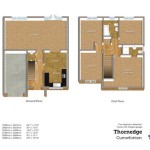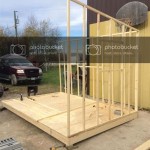Farmhouse Desk Building Plans: A Comprehensive Guide
The farmhouse aesthetic, characterized by its simplicity, functionality, and rustic charm, has gained considerable popularity in interior design. One key element in achieving this style within a home office or study is the farmhouse desk. This article provides a comprehensive guide to understanding and implementing farmhouse desk building plans, covering essential aspects such as design considerations, material selection, construction techniques, and finishing options.
A well-designed farmhouse desk can serve not only as a functional workspace but also as a statement piece that enhances the overall ambiance of a room. The unique blend of traditional and modern elements makes it a versatile choice for various interior styles. Furthermore, building a farmhouse desk offers the satisfaction of creating a custom piece of furniture that perfectly aligns with individual needs and preferences.
Key Design Considerations for Farmhouse Desks
The design phase is crucial in ensuring that the final product meets the user's expectations. Several factors should be taken into account, including desk size, storage requirements, and overall aesthetic. The size of the desk should be proportional to the room it will occupy, allowing for comfortable movement and sufficient workspace. Consider the dimensions of the room and the intended use of the desk when determining its length, width, and height.
Storage needs are another important consideration. Farmhouse desks can incorporate various storage solutions, such as drawers, shelves, and cabinets. Evaluate the types of items that will be stored in the desk and design accordingly. For example, if the desk will primarily be used for writing and paperwork, drawers of varying sizes may be sufficient. However, if the desk will also house electronic equipment or larger items, open shelves or cabinets may be more appropriate.
The overall aesthetic should align with the existing décor of the room. Farmhouse desks typically feature clean lines, a sturdy construction, and a distressed or weathered finish. Consider incorporating design elements such as X-shaped supports, turned legs, or decorative hardware to enhance the farmhouse style. The color palette should also complement the room's existing colors. Neutral tones, such as white, gray, and beige, are commonly used in farmhouse designs, but bolder colors can also be incorporated as accents.
Choosing the right design software or referencing existing plans is crucial. Software can aid in visualizing the final product and calculating material requirements accurately. Reputable online resources and woodworking communities offer a variety of free and paid farmhouse desk plans, which can serve as a starting point or be customized to meet specific needs.
Material Selection for Durability and Aesthetics
The choice of materials significantly impacts the durability, appearance, and cost of the farmhouse desk. Solid wood is a popular choice for its strength, natural beauty, and timeless appeal. Common wood species used in farmhouse desk construction include pine, oak, maple, and reclaimed wood.
Pine is an affordable and readily available option that offers a warm, rustic look. It is relatively soft, making it easy to work with, but it is also susceptible to dents and scratches. Oak is a more durable and dense wood that offers excellent resistance to wear and tear. It has a distinctive grain pattern that adds character to the desk. Maple is a hardwood that is known for its smooth, even texture and light color. It is a versatile wood that can be stained or painted to achieve various finishes. Reclaimed wood is an environmentally friendly option that adds a unique, weathered look to the desk. It can be sourced from old barns, buildings, or furniture.
In addition to solid wood, other materials can be incorporated into the design. Plywood can be used for drawer boxes or cabinet panels to reduce cost and weight. Metal accents, such as drawer pulls, hinges, and legs, can add an industrial touch to the farmhouse style. Glass panels can be used for cabinet doors or as a decorative element.
When selecting materials, consider the overall budget, the desired aesthetic, and the level of durability required. It is also important to source materials from reputable suppliers to ensure quality and consistency. Properly acclimating the wood to the environment in which the desk will be used is crucial to prevent warping or cracking.
Construction Techniques and Assembly
Proper construction techniques are essential for building a sturdy and long-lasting farmhouse desk. Before starting the assembly process, carefully review the plans and gather all necessary tools and materials. Accuracy in cutting and joining the wood components is critical for achieving a professional-looking result.
Common joinery methods used in farmhouse desk construction include screws, nails, dowels, and mortise-and-tenon joints. Screws and nails are relatively easy to use and provide a strong connection. Dowels offer a clean, seamless look and can be used to reinforce joints. Mortise-and-tenon joints are more complex to create but provide exceptional strength and stability. The choice of joinery method depends on the specific application and the desired level of skill and experience.
The assembly process typically involves constructing the frame, attaching the legs, installing the drawers or shelves, and adding any decorative elements. Ensure that all components are properly aligned and securely fastened. Use wood glue in addition to screws or nails to strengthen the joints and prevent movement. Clamps can be used to hold the components in place while the glue dries.
Pay particular attention to the stability of the desk. The legs should be securely attached to the frame and properly braced to prevent wobbling. Consider adding adjustable feet to the legs to compensate for uneven floors. Regularly inspect the desk for loose screws or joints and tighten them as needed.
Safety precautions are paramount during the construction process. Wear appropriate safety gear, such as safety glasses and ear protection, when using power tools. Work in a well-ventilated area to avoid inhaling dust or fumes. Follow the manufacturer's instructions for all tools and materials.
Finishing and Protecting the Farmhouse Desk
The finishing process is crucial for enhancing the aesthetic appeal and protecting the farmhouse desk from damage. A variety of finishes can be used to achieve the desired look, including paint, stain, varnish, and wax. The choice of finish depends on the type of wood used, the desired level of durability, and the overall aesthetic.
Paint is a popular choice for achieving a clean, modern farmhouse look. It can be applied in various colors and finishes, such as matte, satin, or gloss. Consider using milk paint or chalk paint for a more authentic farmhouse look. Stain is used to enhance the natural grain pattern of the wood and add color. It penetrates the wood fibers and provides a durable, long-lasting finish. Varnish is a clear coat that provides protection against scratches, moisture, and UV light. It can be applied in various sheens, such as matte, satin, or gloss. Wax is a natural finish that provides a soft, subtle sheen and protects the wood from moisture. It is typically applied over paint or stain to enhance the finish and add depth.
Before applying any finish, properly prepare the wood surface by sanding it smooth and removing any dust or debris. Apply a primer or sealer to the wood to improve adhesion and prevent the finish from soaking into the wood unevenly. Apply multiple thin coats of finish, allowing each coat to dry completely before applying the next. Sand lightly between coats to remove any imperfections and create a smooth, even surface.
Consider applying a distressed or weathered finish to enhance the farmhouse style. This can be achieved by sanding the edges and corners of the desk to reveal the underlying wood, or by using techniques such as dry brushing or antiquing. Protect the finish with a clear coat of varnish or wax to prevent scratches and stains. Regularly clean the desk with a damp cloth and avoid using harsh chemicals or abrasive cleaners.
By carefully considering the design, materials, construction techniques, and finishing options, individuals can successfully build a beautiful and functional farmhouse desk that will last for years to come. Investing time and effort into the planning and execution of the project will result in a custom piece of furniture that perfectly complements the home and enhances the overall living space.

Farmhouse Desk Step By Instructions Chisel Fork

Farmhouse Desk Plans Diy Woodworking Easy

Diy Farmhouse Desk Free Building Plans The Creative Mom

Farmhouse Desk Ana White

Farmhouse Desk Step By Instructions Chisel Fork

Diy Modern Farmhouse Desk Plans And Anika S Life

Rustic X Desk Ana White
:max_bytes(150000):strip_icc()/ana-white-farmhouse-table-56af6cb25f9b58b7d018abce.jpeg?strip=all)
14 Free Diy Woodworking Plans For A Farmhouse Table

Farmhouse Desk Planswith Pictures

Farmhouse Desk Step By Instructions Chisel Fork








